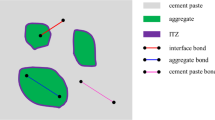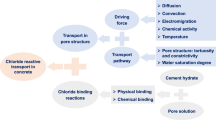Abstract
The boundary element method (BEM) has been widely employed in engineering practice. However, the BEM is not commonly used in numerical analysis of chloride diffusion in concrete and might yield unsatisfactory results if the time duration is significantly long for concrete exposed to chloride environment. In this work, we propose the compensation length of chloride diffusion in concrete, as well as the compensation coefficient based on the error function. The fundamental solution relevant to the governing partial differential equation is presented for chloride diffusion in concrete, enabling the development of the boundary element scheme. In particular, the two-dimensional diffusion analysis is investigated in detail by using the BEM model, featuring the proposed compensation length to achieve superior numerical results. Specifically, the time interval is sparsely discretized into several sub-domains in the BEM model, while the spatial domain is discretized along the boundary of the computational diffusion field, resulting in considerably fewer unknowns in chloride diffusion analysis. Several numerical examples are presented to demonstrate the effectiveness and accuracy of the BEM with compensation length and to illustrate excellent results using the 2-D BEM formulation for chloride diffusion near the intersection of exposed surfaces of concrete specimens.
Similar content being viewed by others
References
Oh B.H., Jang B.S.: Chloride diffusion analysis of concrete structures considering effects of reinforcements. ACI Mater. J. 100(2), 143–149 (2003)
Jensen O.M., Hansen P.F., Coats A.M., Glasser F.P.: Chloride ingress in cement paste and mortar. Cem. Concr. Res. 29, 1497–1504 (1999)
Goltermann P.: Chloride ingress in concrete structures: extrapolation of observations. ACI Mater. J. 100(2), 114–119 (2003)
McGrath P.F., Hooton R.D.: Influence of voltage on chloride diffusion coefficients from chloride migration tests. Cem. Concr. Res. 26(8), 1239–1244 (1996)
Collepardi M., Marcialis A., Turrizzani R.: Penetration of chloride ions into cement pastes and concretes. J. Am. Ceram. Soc. 55(10), 534–535 (1972)
Tang L., Nilsson L.O.: Chloride binding capacity and binding isotherms of OPC pastes and mortars. Cem. Concr. Res. 23, 247–253 (1993)
Liang M.T., Wang K.L., Liang C.H.: Service life prediction of reinforced concrete structures. Cem. Concr. Res. 29, 1411–1418 (1999)
Kassir M.K., Ghosn M.: Chloride-induced corrosion of reinforced concrete bridge decks. Cem. Concr. Res. 32(1), 139–143 (2002)
Tang L.P., Gulikers J.: On the mathematics of time-dependent apparent chloride diffusion coefficient in concrete. Cem. Concr. Res. 37, 589–595 (2007)
Funanshi M.: Prediction corrosion-free service life of a concrete structure in a chloride environment. ACI Mater. J. 87(6), 581–587 (1990)
Song H.W., Shim H.B., Petcherdchoo A., Park S.K.: Service life prediction of repaired concrete structures under chloride environment using finite difference method. Cem. Concr. Compos. 31, 120–127 (2009)
Sergi H., Page C.: Diffusion of chloride and hydroxyl ions in cementitious materials exposed to a saline environment. Mag. Concr. Res. 44, 63–69 (1992)
Han S.H.: Influence of diffusion coefficient on chloride ion penetration of concrete structure. Constr. Build. Mater. 21, 370–378 (2007)
Wang Y., Li L.Y., Page C.L.: Modelling of chloride ingress into concrete from a saline environment. Build. Environ. 40, 1573–1582 (2005)
Wang Y., Li L.Y., Page C.L.: A two-dimensional model of electrochemical chloride removal from concrete. Comput. Mater. Sci. 20, 196–212 (2001)
Suryavanshi A.K., Swamy R.N., Cardew G.E.: Estimation of diffusion coefficient for chloride ion penetration into structural concrete. ACI Mater. J. 99, 441–449 (2002)
Yang L.F., Li R.: Analytical study of two-dimensional diffusion of chloride ion in concrete. Adv. Sci. Technol. Water Resour. 29, 20–23 (2009)
Bitaraf M., Mohammadi S.: Analysis of chloride diffusion in concrete structures for prediction of initiation time of corrosion using a new meshless approach. Constr. Build. Mater. 22, 546–556 (2008)
Li, R., Yang, L.F., Chen, Z.: Two-dimensional finite element simulation for chloride diffusion in concrete. J. Concr. (1), 36–39 (in Chinese) (2008)
Li, R., Yang, L.F., Feng, Q.G.: Analysis of chloride diffusion in concrete based on the initial age and ageing coefficient of concrete. J. Concr. (7), 40–44 (in Chinese) (2008)
Yang, L.F., Chen, Z., Wang, Y.: Analysis of chloride diffusion in concrete by the boundary element method. J. Concr. (9), 25–28 (in Chinese) (2008)
Yang L.F., Chen Z., Wang Y.: Boundary element method for analysis of two-dimensional chloride diffusion in concrete. J. Chin. Ceram. Soc. 37(7), 1110–1117 (2009) (in Chinese)
Chen Z., Yang L.F., Feng Q.G.: Analysis of chloride diffusion in high-performance concrete and its service life by the boundary element method. J. Build. Mater. 13(2), 97–103 (2010) (in Chinese)
Author information
Authors and Affiliations
Corresponding authors
Additional information
Lu Feng Yang is supported by the Guangxi Lab Center of Science and Technology (LGZX201002).
Rights and permissions
About this article
Cite this article
Yang, L.F., Chen, Z., Gao, Q. et al. Compensation length of two-dimensional chloride diffusion in concrete using a boundary element model. Acta Mech 224, 123–137 (2013). https://doi.org/10.1007/s00707-012-0721-1
Received:
Revised:
Published:
Issue Date:
DOI: https://doi.org/10.1007/s00707-012-0721-1




